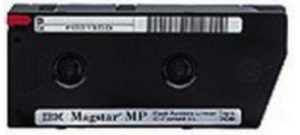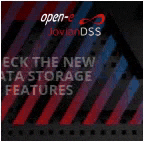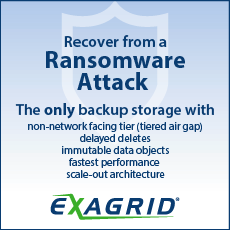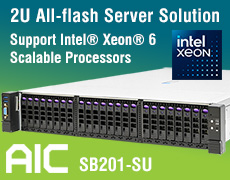History (1996): New IBM Tape Cartridge 3570 Format at Native 5GB
With two spindles, supplied by Imation
By Jean Jacques Maleval | July 28, 2021 at 2:00 pmIBM SSD announced a new cartridge library this month, the 3570 Magstar MP (Multi-Purpose) Tape Subsystem, with native capacity of 100GB and a particularly high access time, for the backup of network computers, that will use an entirely new cartridge.

The 20-cartridge library (5GB per cartridge) will contain a drive that uses a magnetic cartridge with an interleaved serpentine longitudinal recording process on 128 tracks (32 times 4), identical to the highly reliable Magstar 3590 technology for mainframes.
The main difference is in the 3570 cartridge, which looks nothing like the 3590 cartridge, both supplied by Imation. The former includes not one but two spindles and, inside, a 3/8-inch tape, according to an Imation representative, a width never before seen. We’ve already seen widths of 4mm, 8mm, quarter-inch (6.35mm), half-inch (12.7mm), but never the peculiar 3/8-inch (9.5mm).
Thus we now have a new proprietary standard that is entirely not compatible with anything already on the market, not even with the half-inch 3590 tape.
Access time will be considerably faster, for two reasons. On the 3590 (as with DLT), the drive is obliged to locate the tape leader, then must wind through at least half the reel in order to access a file. With the new cartridge, the tape starts in the middle, where the index of files is located, so that no more than a quarter of the tape’s length must be searched to locate the desired data.
Furthermore, the drive head on the 3570 extends into the cartridge to make contact with the tape, and therefore doesn’t have to seek out the tape to thread it past the head. According to IBM, an average seek time of 8s (30s on the 3590) can be reached, well under those of current competitor technology, be they the 4mm DDS-3, 8mm Exabyte, Sony and Quantum’s DLT or Tandberg’s QIC. Load time for the cartridge is also remarkable at a mere 8s. Transfer rate on the 3570 is 2.2MB/s without data compression, however, a figure which is inferior to the 5MB/s offered by the DLT700 or the 3MB/s on the most recent 8mm drives.
SCSI-2 interface will permit connection with IBM’s AS/400 and RS/6000 computers.
IBM will also adopt the LZ1 system of data compression in order to triple transfer rates eventually.
The Magstar MP 20 cartridge library, available, lists at $14,900, with one drive (a second drive will be available as an option beginning 1Q97). The drive will be available separately in November for $8,500 a price closer to that of the DLT7000 rather than that of Mammoth or the DLT 4000. Cartridges are $76, unit price, in packages of 10.
IBM’s announcement comes nevertheless as something of a surprise, since Big Blue is launching a new standard in the mid-range computer environment, which already bears a surplus of standards.
In this particular product and market niche, which is actually growing by leaps and bounds, the house is packed and confusion about various technologies and standards, already considerable, is now total, making it nearly impossible to make predictions about the success of each individual technology arriving on the market.
IBM continues, furthermore, to offer QIC, 4mm, 8mm (they are Exabyte’s largest customer, although the latter firm can now count yet another competitor), along with 36- and 128-track tape. DLT is supported by ADSM software, but is not sold by Big Blue. IBM has also just confirmed its confidence in Tandberg, a long-time supplier with more than half a million drives sold, by placing its first orders for MLR1 (13GB without compression on a QIC cartridge) to be integrated in AS/400 units.
Magstar MP’s trump card, ultimately, is the speed of data access in the library, especially when compared with DLT. But its capacity is too limited, and transfer rates are less than stellar.
One might thus conclude that the product is better adapted for backup purposes, or for searching small files, and thus could pose the greatest threat to optical disk libraries.
Also, to succeed, outside of the captive market, IBM will have to win over storage management software firms, library manufacturers, integrators and above all OEMs, who are particularly courted these days. IBM, as always, has the singular disadvantage of being all these things at once.
In addition, Barbara Grant, VP, IBM SSD, removable media storage solutions, clarified that the company delivered 5,000 Magstar 3590 drives throughout the world at the end of July. Escon connectivity will be available in October. An SSA interface version is expected for early 1998. The much-anticipated volume stacking (internal code name Barracuda) for mainframes, an adapted OS addition that will permit recording of more than one file per cartridge, should arrive in 1Q97. Grant indicates also that IBM is looking for a second source manufacturer for its Magstar units, to whom the firm can ultimately sell its MR tape heads.
This article is an abstract of news published on the former paper version of Computer Data Storage Newsletter on issue 104, published on September 1996.
Note: However, slower tape technologies with higher per-tape capacities proved more successful in the marketplace, and the IBM 3570 technology did not enjoy a large market penetration.














 Subscribe to our free daily newsletter
Subscribe to our free daily newsletter


